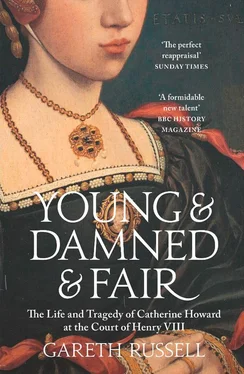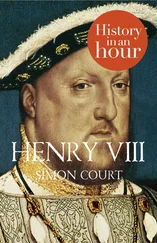That will left Edmund’s stepmother Agnes as one of the wealthiest independent women in England. As dowager duchess, she would no longer have access to Framlingham Castle as her home, but she had periodic use of Norfolk House in Lambeth and full-time access to a sizeable country estate near the village of Horsham in Sussex. With the exception the eldest son, none of the old duke’s surviving children, including Edmund, expected much of a windfall from their father’s final testament. While provisions were usually made to fund younger sons’ education or early careers, to prevent the destruction of the family’s patrimony by generations of division by bequests, the nobility endeavoured to pass the inheritance more or less intact to the next in line.29 The other siblings’ absence from the will was not therefore a matter for shock or confusion; younger sons could and often did parlay their family name and connections into successful careers of their own. One of the most remarkable aspects of the system was the extent to which even those left out of the posthumous treasure trove seemed to support it as necessary for the common good.
However, two of the Howard siblings had reason to rue the custom that dictated an undiluted inheritance for the new patriarch: Edmund and Anne, both of whom had come to rely on their father’s help.30 Anne was trapped in a miserable marriage to the twenty-five-year-old Earl of Oxford, who, two years earlier, had been sent to live in his father-in-law’s household like an errant child when the royal court decided that his immoderate drinking, dereliction of duty, and reckless spending were besmirching one of the oldest names in the country.31 With the duke dead, the chances of the adult earl being allowed to return to his hedonism were much improved, and Anne, like most wives, remained dependent on her husband’s generosity.32 For Edmund, his father’s death robbed him of his principal benefactor and patron, adding to the financial worries afflicting him at the time of Catherine’s birth.
In addition to a very large family, their surnames reading like a who’s who of Henry VIII’s England, the Duke of Norfolk’s funeral was also attended by thousands of others, including ‘many great Lords, and the Noble men of both Shires of Norfolk and Suffolk’, who arrived at Framlingham to pay their respects to the old duke and solidify ties to the new.33 The kaleidoscope of different servants’ liveries danced through the other guests, the priests, monks, guards, squires, and common people who gathered in the shade of the castle’s walls or lined the route to the Benedictine priory at Thetford, where the duke’s tomb had been prepared.
When Framlingham’s gates, crowned by the Howard coat of arms, swung open, the long cavalcade of choreographed grief snaked its way under the arch and down the hill, passing two artificial lakes, with a dovecote on the manmade island in the middle of the largest body of water. Combined, Framlingham’s two lakes, which were constructed after the damming of a nearby stream, covered nearly twenty-three acres, a perfect reflecting pool for the castle’s thirteen towers, slightly lowered on the Howards’ order to further emphasise the impressive size of the walls. Fashionable red brick extensions, remodelled gardens, new chambers, and the latest in Renaissance design had also been added at the family’s instructions.
As was customary for the aristocratic elite, a wax effigy topped the duke’s bier, rendered as lifelike as possible by the artisans entrusted with the task. One hundred smaller wax effigies had been placed beneath it, representing those who mourned, while space for 700 candles had been set aside, so that even when it travelled at twilight or rested at night, the Duke of Norfolk, and through him the House of Howard, could be illuminated for those hoping to catch a glimpse. Four hundred men, hooded as a sign of mourning and penitence, were assigned to carry torches. Ten thousand people received charitable bequests under the terms of the duke’s will, with the money paid out at the time of the funeral in the hope of encouraging prayers for his posthumous redemption, as well as to display the largesse that the aristocracy prided themselves on. In total, the funeral cost nearly £1,300, at a time when the average weekly income of a skilled worker was about twenty-six pence, and pre-decimalisation of the currency there were 240 pence in every pound.34
The Howards’ quartered coat of arms was displayed on pennants and a thousand cloaks throughout the parade. Four lions could be found on the shield and one as the crest, the motif broken in the third quarter by a chequered blue-and-gold field that advertised their possession of the earldom of Surrey. The first quarter had the original Howard coat of arms scaled down to make room for the arms that proclaimed their descent from King Edward I, in the second quarter, and beneath that, the earls of Arundel.
No less than many of their contemporaries, Catherine’s family were fascinated with the tangled limbs and roots of their family tree. She could claim distant descent from Adeliza of Louvain, a twelfth-century queen who was subsequently the Countess of Lincoln and Arundel.35 Later generations of the Howards eulogised Adeliza, with only marginal exaggeration, as ‘a Lady of transcendent beauty, grace and manner, of peculiar gentleness of disposition, added to true virtue and piety’.36 However, there were other less exalted ancestors who had played a more deliberate role in pushing the Howards to the apex of English society – the first recorded mention of the family places them to the village of East Winch in Norfolk, about three centuries before Catherine’s birth. From there, a family associated with law and commerce had risen through a shrewd policy of exemplary civil service, coupled with unions with the daughters of similarly wealthy businessmen and, eventually, the sons and daughters of the local nobility. They had been introduced to the court of King Edward I and used their money to raise troops for the king’s wars and those of his son, Edward II.37 In the fourteenth century, they had married into the powerful de Mowbray family, which eventually brought them the dukedom of Norfolk after they continued to serve the Crown and, crucially, supported the winning side in the dynastic conflicts of the 1400s.
Their luck seemed to have deserted them when the first Howard duke, John, enjoyed his new dukedom for just over two years, until he was killed supporting King Richard III at Bosworth Field in August 1485. That battle brought the Tudors to power after decades of exile on the Continent, and unsurprisingly they took a decidedly dim view of the Howards’ Ricardian loyalties. Fortunately, unlike Edward IV or Richard III, Henry VII understood that irreversible punishments turned the aristocracy into implacable enemies. Instead of destroying the Howards, he therefore decided to demote them and then promote them again, at his pleasure. Luckily, the Howards had not lost their genetic knack for climbing and they proved adept at playing the unpleasant game the new king set for them.
John Howard’s heir and Catherine Howard’s future grandfather, thirty-nine-year-old Thomas, had also fought for King Richard III at Bosworth. Unlike his lord father, he was wounded but survived the battle.38 Much was made later of Thomas’s insistence that he would always fight for England’s true king, regardless of who that king was, but even such protestations of patriotic zeal made over Richard III’s not-quite-cold corpse were insufficient to convince the Tudors that Howard should go unpunished.39 Henry VII could not afford to be seen as weak, particularly where the aristocracy was concerned. His late uncle, the deeply unfortunate Henry VI, had ended his life deposed and murdered in the Tower of London. For a medieval king, unfettered mercy could create as many problems as unchecked tyranny. Thomas Howard was therefore temporarily banned from inheriting his father’s titles, a large slice of the Howard fortune was handed over to the Tudor loyalist, the Earl of Oxford, and Howard himself was sent to the Tower of London, where he spent the next three years as a prisoner.40
Читать дальше











![John Bruce - The Lettsomian Lectures on Diseases and Disorders of the Heart and Arteries in Middle and Advanced Life [1900-1901]](/books/749387/john-bruce-the-lettsomian-lectures-on-diseases-and-disorders-of-the-heart-and-arteries-in-middle-and-advanced-life-1900-1901-thumb.webp)
